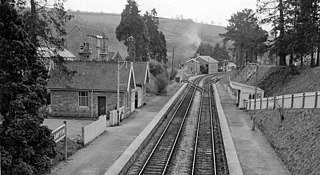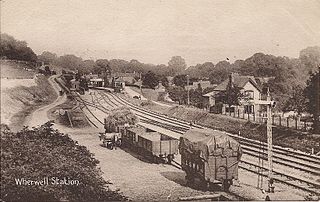
The Wessex Main Line is the railway line from Bristol Temple Meads to Southampton Central. Diverging from this route is the Heart of Wessex Line from Westbury to Weymouth. The Wessex Main Line intersects the Reading to Taunton Line at Westbury and the West of England Main Line at Salisbury.

The West of England line is a British railway line from Basingstoke, Hampshire, to Exeter St Davids in Devon, England. Passenger services run between London Waterloo station and Exeter; the line intersects with the Wessex Main Line at Salisbury. Despite its historic title, it is not today's principal route from London to the West of England: Exeter and everywhere further west are reached more quickly from London Paddington via the Reading–Taunton line.

Feniton railway station serves the village of Feniton in Devon, England. It was opened by the London and South Western Railway (LSWR) in 1860 but is now operated by South Western Railway which provides services on the West of England Main Line. It is 159 miles 24 chains (256.4 km) down the line from London Waterloo.

Salisbury railway station serves the city of Salisbury in Wiltshire, England. It is 83 miles 43 chains (134.4 km) from London Waterloo on the West of England line to Exeter St Davids. This is crossed by the Wessex Main Line from Bristol Temple Meads to Southampton Central. The station is operated and served by South Western Railway (SWR), and is also served by Great Western Railway (GWR).

Andover railway station serves the town of Andover, Hampshire, England. The station is served and operated by South Western Railway. It is 66 miles 19 chains (106.6 km) down the line from London Waterloo on the West of England Main Line.

Stanmore Village railway station was a station in Stanmore, Middlesex in the south of England. Originally called simply Stanmore, it was opened on 18 December 1890 by the Harrow and Stanmore Railway, a company owned by the hotel millionaire Frederick Gordon, as the terminus of the Stanmore branch line, a short branch line running north from Harrow & Wealdstone. Trains were operated by the London & North Western Railway (LNWR).

The Didcot, Newbury and Southampton Railway (DN&SR) was a cross-country railway running north–south between Didcot, Newbury and Winchester. Its promoters intended an independent route to Southampton and envisaged heavy traffic from the Midlands and North of England to the port, but they ran out of funds to complete the line to Southampton. The intended heavy through traffic never materialised, and the line was dependent on larger railways—the Great Western Railway and the London and South Western Railway—for support, which was not freely given. The line opened in two stages, in 1882 and 1885.
There are 22 disused railway stations in the 75 miles (121 km) between Bristol Temple Meads and Exeter St Davids, 12 of which have structures that can still be seen from passing trains. Most were closed in the 1960s but four of them, especially around Weston-super-Mare, were replaced by stations on new sites. 13 stations remain open on the line today, but there have been proposals to reopen stations at Cullompton and Wellington.

The Exe Valley Railway was a branch line built by the Great Western Railway (GWR) in Devon, England, to link its Bristol to Exeter line with its Devon and Somerset Railway (D&SR), thereby connecting Exeter with Dulverton. The line was in use from 1884 until 1964.
The Sprat and Winkle Line was the common name of the Andover to Redbridge railway line which ran between Andover and Redbridge in Hampshire, England. In the Romsey area it joined, and then left, the Salisbury to Southampton line. It was built by the Andover and Redbridge Railway, which was incorporated in 1858. In 1863 the uncompleted railway was taken over by the London and South Western Railway (LSWR), which opened the line in 1865. The line had been conceived as part of a trunk route from Manchester to Southampton, but when the Midland and South Western Junction Railway opened, the anticipated long distance traffic was disappointing.
The Fullerton Junction to Hurstbourne Line was a 6-mile railway line which ran between Fullerton Junction and Hurstbourne in Hampshire, UK. It was also known as the Longparish Branch and by the nickname of Nile Valley Railway.

Hurstbourne railway station served the village of Hurstbourne Priors in Hampshire, England. It was on the London and South Western Railway's West of England Main Line and was also the junction for the Fullerton to Hurstbourne Line. Trains for the Fullerton line started and stopped at Whitchurch, the next station to the east on the main line.

Collingbourne railway station served the village of Collingbourne Ducis in Wiltshire, England. It was on the Midland and South Western Junction Railway (M&SWJR) and opened on 1 May 1882 on the southern section of the Swindon, Marlborough and Andover Railway (SM&AR) which at that stage terminated at the-then next station to the north, Grafton and Burbage. In 1883, the SM&AR gained running rights over the Great Western Railway branch from Savernake Low Level to Marlborough and through services started between Swindon Town and Andover Junction railway station, and on down the Sprat and Winkle Line to Southampton. The same year, the Swindon and Cheltenham Extension Railway (S&CER) opened north of Swindon as far as Cirencester and in 1884 the SM&AR and the S&CER merged to form the M&SWJR. The line was completed as a through-route from the Midlands to the south coast by the completion of the northern end of the route between Cirencester and Cheltenham in 1891.

Marlborough railway stations refers to the two railway stations which served Marlborough, Wiltshire, England; the town supported two railway routes and Savernake, the junction station at first, later had a second station.

Longparish railway station served the village of Longparish, Hampshire, England from 1885 to 1956 on the Fullerton to Hurstbourne Line.

Wherwell railway station served the village of Wherwell, Hampshire, England, from 1885 to 1956 on the Fullerton to Hurstbourne Line.

Clatford railway station served the village of Goodworth Clatford, Hampshire, England, from 1865 to 1964 on the Sprat and Winkle Line.

Stockbridge railway station served the town of Stockbridge, Hampshire, England, from 1865 to 1964 on the Sprat and Winkle Line.
The Eastleigh to Salisbury line is the railway line from Eastleigh through Romsey to Salisbury in Hampshire, England. It was constructed by the London and South Western Railway in 1857 from Bishopstoke; the station changed its name to Eastleigh in 1889. At Salisbury the line ran to Milford station on the south-eastern margin of the city, but in 1859 and extension to the present-day Salisbury station was built, and the lines from Andover through Salisbury to Yeovil were connected.















